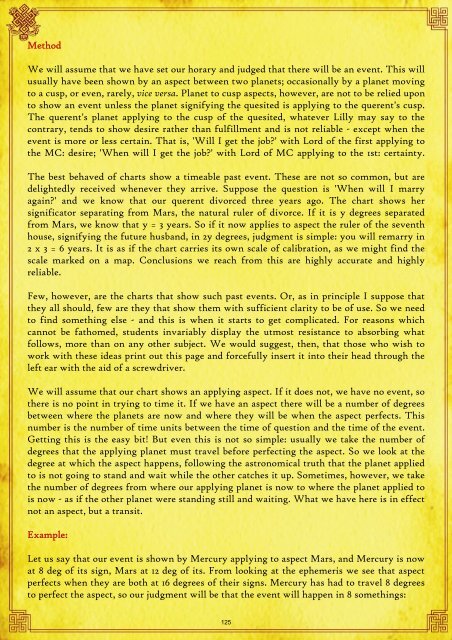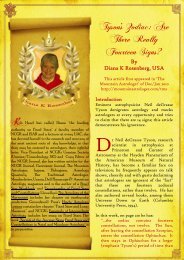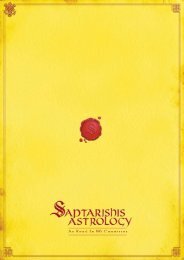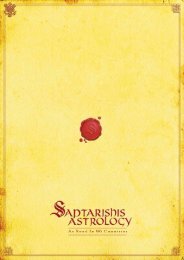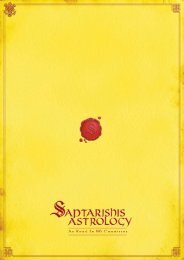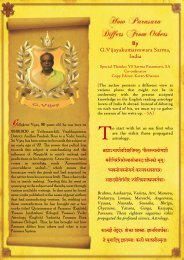How To Beat TimeByJohn Frawley, PolandJohn Frawley is the editor of The Astrologer's Apprentice magazine,and tutor of the Apprenticeship Courses in Horary, Electional andTraditional Natal <strong>Astrology</strong>. John's first book, The Real <strong>Astrology</strong>,was awarded the Spica Award for International <strong>Astrology</strong> Book ofthe Year in 2001. His follow up book, Real <strong>Astrology</strong> Applied, Sports<strong>Astrology</strong> & The Horary Textbook are now available. For details ofJohn's work, publications, appearances and courses, visit hiswebsite at http://www.johnfrawley.com.Aclient entered the workshop one day, gorgeously arrayed and carrying a plumpchicken for payment. "What I would like to know," he asked, as I sat him down inour consulting room, "is, will I die?"I had barely finished rubbing my hands together with glee in order to set the chart when, tomy disappointment, I woke up. For it is ever the reality of horary that clients want not justpredictions, but timed predictions. There, alas, is the rub.Finding the event itself is usually the easy bit; the timing is more difficult, as a close readingof William Lilly makes plain. We see him over and again fumbling towards a plausibleanswer, with the aid either of inside information or a querent sat before him so suggestionscan be bounced back and forth until a feasible result is hammered out. The spectacularanswer, where the timing announces itself in trumpet tones of indisputable clarity, doesoccur; but more often than not, the exact timing of a specific event in horary is hedgedaround with cautions and probabilities.This is both salutary and inevitable. On the one hand it keeps the burgeoning egos ofjourneyman astrologers in check; on the other, as when we look at time we are looking at thevery stuff of which our astrology is made - looking, as it were, not so much at the face of theclock, where the events that mark time are displayed, but into the workings of the clockitself - the fathoming of time is bound to be harder than the mere tracking of events.The conclusions about the nature of time to which the practice of an accurate, verifiableastrology directs us are not the least of the benefits of directing our attention to the celestialscience. Two key works to which I might direct the curious reader are 'Plato's Myth of Er',at the end of his Republic, and Iain Mackenzie's The Anachronism of Time (Norwich, 1994),which is hard work, but which, with a tight logic, clarifies the concepts with which we mustwork. But we direct our attention here away from our prison bars to the more immediatelypractical purpose of finding the answer in the chart.124
MethodWe will assume that we have set our horary and judged that there will be an event. This willusually have been shown by an aspect between two planets; occasionally by a planet movingto a cusp, or even, rarely, vice versa. Planet to cusp aspects, however, are not to be relied uponto show an event unless the planet signifying the quesited is applying to the querent's cusp.The querent's planet applying to the cusp of the quesited, whatever Lilly may say to thecontrary, tends to show desire rather than fulfillment and is not reliable - except when theevent is more or less certain. That is, 'Will I get the job?' with Lord of the first applying tothe MC: desire; 'When will I get the job?' with Lord of MC applying to the 1st: certainty.The best behaved of charts show a timeable past event. These are not so common, but aredelightedly received whenever they arrive. Suppose the question is 'When will I marryagain?' and we know that our querent divorced three years ago. The chart shows hersignificator separating from Mars, the natural ruler of divorce. If it is y degrees separatedfrom Mars, we know that y = 3 years. So if it now applies to aspect the ruler of the seventhhouse, signifying the future husband, in 2y degrees, judgment is simple: you will remarry in2 x 3 = 6 years. It is as if the chart carries its own scale of calibration, as we might find thescale marked on a map. Conclusions we reach from this are highly accurate and highlyreliable.Few, however, are the charts that show such past events. Or, as in principle I suppose thatthey all should, few are they that show them with sufficient clarity to be of use. So we needto find something else - and this is when it starts to get complicated. For reasons whichcannot be fathomed, students invariably display the utmost resistance to absorbing whatfollows, more than on any other subject. We would suggest, then, that those who wish towork with these ideas print out this page and forcefully insert it into their head through theleft ear with the aid of a screwdriver.We will assume that our chart shows an applying aspect. If it does not, we have no event, sothere is no point in trying to time it. If we have an aspect there will be a number of degreesbetween where the planets are now and where they will be when the aspect perfects. Thisnumber is the number of time units between the time of question and the time of the event.Getting this is the easy bit! But even this is not so simple: usually we take the number ofdegrees that the applying planet must travel before perfecting the aspect. So we look at thedegree at which the aspect happens, following the astronomical truth that the planet appliedto is not going to stand and wait while the other catches it up. Sometimes, however, we takethe number of degrees from where our applying planet is now to where the planet applied tois now - as if the other planet were standing still and waiting. What we have here is in effectnot an aspect, but a transit.Example:Let us say that our event is shown by Mercury applying to aspect Mars, and Mercury is nowat 8 deg of its sign, Mars at 12 deg of its. From looking at the ephemeris we see that aspectperfects when they are both at 16 degrees of their signs. Mercury has had to travel 8 degreesto perfect the aspect, so our judgment will be that the event will happen in 8 somethings:125
- Page 2:
Special Thanks(In Alphabetical Orde
- Page 5:
33 New Light On Jaimini Astrology-4
- Page 8 and 9:
Richard Gehman gives a time of 7:54
- Page 10 and 11:
It is difficult to explain any char
- Page 12 and 13:
not ignore them as interpretation o
- Page 14 and 15:
method that was revealed last year
- Page 16 and 17:
thereby activating 3H of death, als
- Page 18 and 19:
See in his 6H the planet of Music &
- Page 20:
They say if you work in the Hollywo
- Page 23 and 24:
Earth (US President is considered t
- Page 26 and 27:
With the Indian Zodiac Chart 6H is
- Page 28 and 29:
here is an ICAS 12 teacher, a vorac
- Page 30 and 31:
either he must have gotten married
- Page 32 and 33:
manuscripts lying untouched in ever
- Page 34 and 35:
its and pieces and made you crave f
- Page 36 and 37:
|| Gururbrahmaa Gururvishnu Gururde
- Page 38 and 39:
cannot make such predictions. Peopl
- Page 40 and 41:
1) If you ask anyone in astrology w
- Page 42 and 43:
8) Now ask anyone which is the hous
- Page 44 and 45:
Experiences In Nadi VIII’ and cou
- Page 46 and 47:
Today more ill-karma is done in the
- Page 48 and 49:
answer - there are 70 types of dasa
- Page 50 and 51:
You use I am old fashioned and don
- Page 52 and 53:
) Observe thus the signs houses in
- Page 54 and 55:
Ketu in Gemini means debt towards a
- Page 56 and 57:
When Will I FindMy Next Job?ByAndre
- Page 58 and 59:
its dignity by triplicity. 2 Mercur
- Page 60:
Querent was worried and very unsure
- Page 63 and 64:
But the job is signified by Venus L
- Page 65 and 66:
ConfiguracionesUniversales Hacia El
- Page 67 and 68:
Saturno es su planeta regente.El si
- Page 69 and 70:
Los eventos que ahora se asocian a
- Page 71 and 72:
que rigen al universo, el tiempo, l
- Page 73 and 74: En una sociedad en crisis como pare
- Page 75 and 76: La NASA anuncia el calentamiento gl
- Page 77 and 78: para preservar la libertad, el resp
- Page 79 and 80: tienen, y entre las clases en el po
- Page 81 and 82: The TortugueroMonument 6 & theMayan
- Page 83 and 84: or translated to English: “The Th
- Page 85 and 86: consequence, serious researchers ne
- Page 87 and 88: What is about to transpire now is i
- Page 89 and 90: the evolution of this. We should th
- Page 91 and 92: this will be preceded on a larger s
- Page 93 and 94: On the other hand the ancient Maya
- Page 95 and 96: So if you look at the last picture,
- Page 97 and 98: He started his 1 st attack (Mars an
- Page 99 and 100: Lunar Return onAirlinersByCiro Disc
- Page 101 and 102: On Giovanna Bianco & Pino Valente
- Page 103 and 104: Rivoluzione Lunare OrabiRivoluzione
- Page 105 and 106: Geographical Map105
- Page 107 and 108: $1.36 trillion, or 34.1% of the tot
- Page 109 and 110: 2005From the end of 2004, Jupiter m
- Page 111 and 112: Awakening the InnerSense - SomeMeth
- Page 113 and 114: inner sense means choosing a medita
- Page 115 and 116: Eye floaters: Mobile transparent do
- Page 118 and 119: Discover The ChildWithinByHolly Hal
- Page 120 and 121: 4. If you have any planets in any o
- Page 122 and 123: CAPRICORN - Much like your Virgo si
- Page 126 and 127: days, weeks, months, years, whateve
- Page 128 and 129: would like to be able to quote a ru
- Page 130 and 131: girl's father. The twelfth being th
- Page 132 and 133: The Moon applies to aspect Saturn i
- Page 134 and 135: I am sure that we all list amongst
- Page 136 and 137: when we have nothing to lose our li
- Page 138 and 139: Launch Your BookWhy Astrology Is Sc
- Page 140 and 141: Deathin AstrologybyRon Bippus, Cana
- Page 142 and 143: emotional stress triggered his deat
- Page 144 and 145: especially in the 1 st or 10 th hou
- Page 146 and 147: Mon (4) Sqr Ven (1) (X) Sp-Na 3 Nov
- Page 148 and 149: Sa Venus conjunct Vindemiatrix, Sa
- Page 150 and 151: Mon (1) Cnj Sat (1) X) Tp-Na 14 Aug
- Page 152 and 153: Leo in the 5 th of acting and trine
- Page 154 and 155: 22. Coco Chanel - 19 Aug 1883, 16:0
- Page 156 and 157: 28. Isaac Hayes - 20 Aug 1942, 3:50
- Page 158 and 159: You mentioned your different method
- Page 160 and 161: Can you give an example for both ca
- Page 162 and 163: Jacko’s - BirthTime Rectification
- Page 165 and 166: 0 44Focus /11.515Focus /13In both c
- Page 167 and 168: Regarding Uranus at 17SAGIf we comp
- Page 169 and 170: In addition we may find solar trans
- Page 171 and 172: How To PredictStock Market Crashes&
- Page 173 and 174: autumn of 2008. Still within the cr
- Page 175 and 176:
September 11, 2001: Pluto and Chiro
- Page 177 and 178:
of an opposition to the US Sun. Thi
- Page 179 and 180:
Similarity BetweenQuantum Mechanics
- Page 181 and 182:
atom which prevents them from spira
- Page 183 and 184:
the Earth releasing showers of gamm
- Page 185 and 186:
accepted as a science by the scient
- Page 187 and 188:
institutions”. (1)From this point
- Page 189 and 190:
stars (planets), they cause those w
- Page 191 and 192:
with the aid of spheres. The whole
- Page 193 and 194:
Or is it both?The one determining f
- Page 195 and 196:
(3) Slightly curving Mercury finger
- Page 197:
'If you put the sand into the jar f


